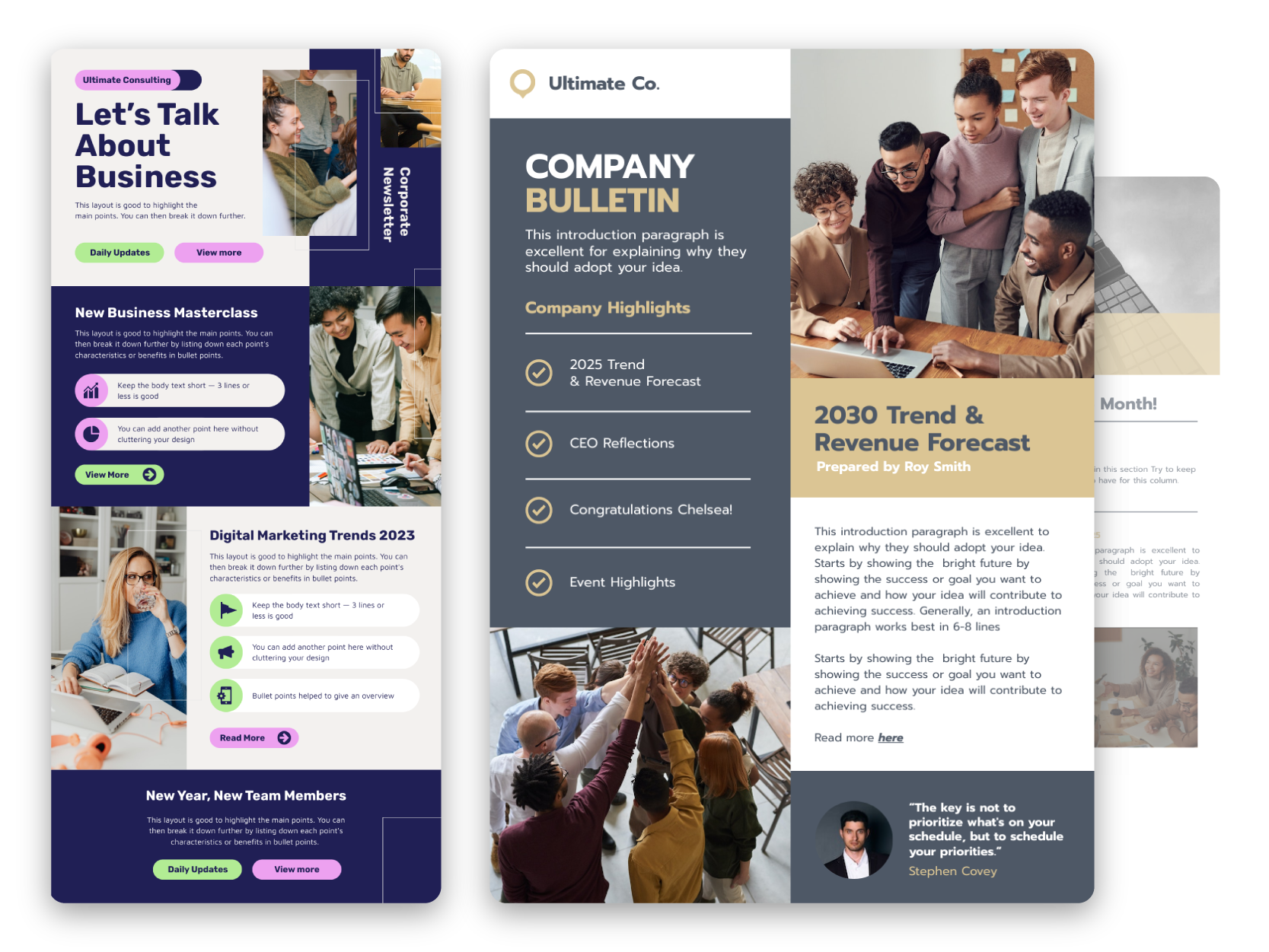Picture a workplace buzzing with energy, where every team member plays an important role, just like parts in a smoothly running machine. Their commitment is clear and strong. But, truthfully, not many workplaces actually feel like this.
A recent Gallup report reveals only about 23% of employees feel involved and committed at work.
This isn’t too shocking, especially now that many companies are still figuring out how to balance office work with remote and hybrid work setups. Knowing the best times and ways to communicate with your team can be tricky.
So, what’s the secret to increasing employee engagement? It goes beyond just having people at their desks. The goal is to spark something inside each person, turning their job into something they’re passionate about. This means adopting strategies that really connect with your team, making sure they feel listened to, valued, and essential to the company’s goals.
Don’t worry, though. We’re here to help. We’ll share strategies and tips to help you connect more deeply with your team.
First, let’s tackle an important question: what exactly is employee engagement?
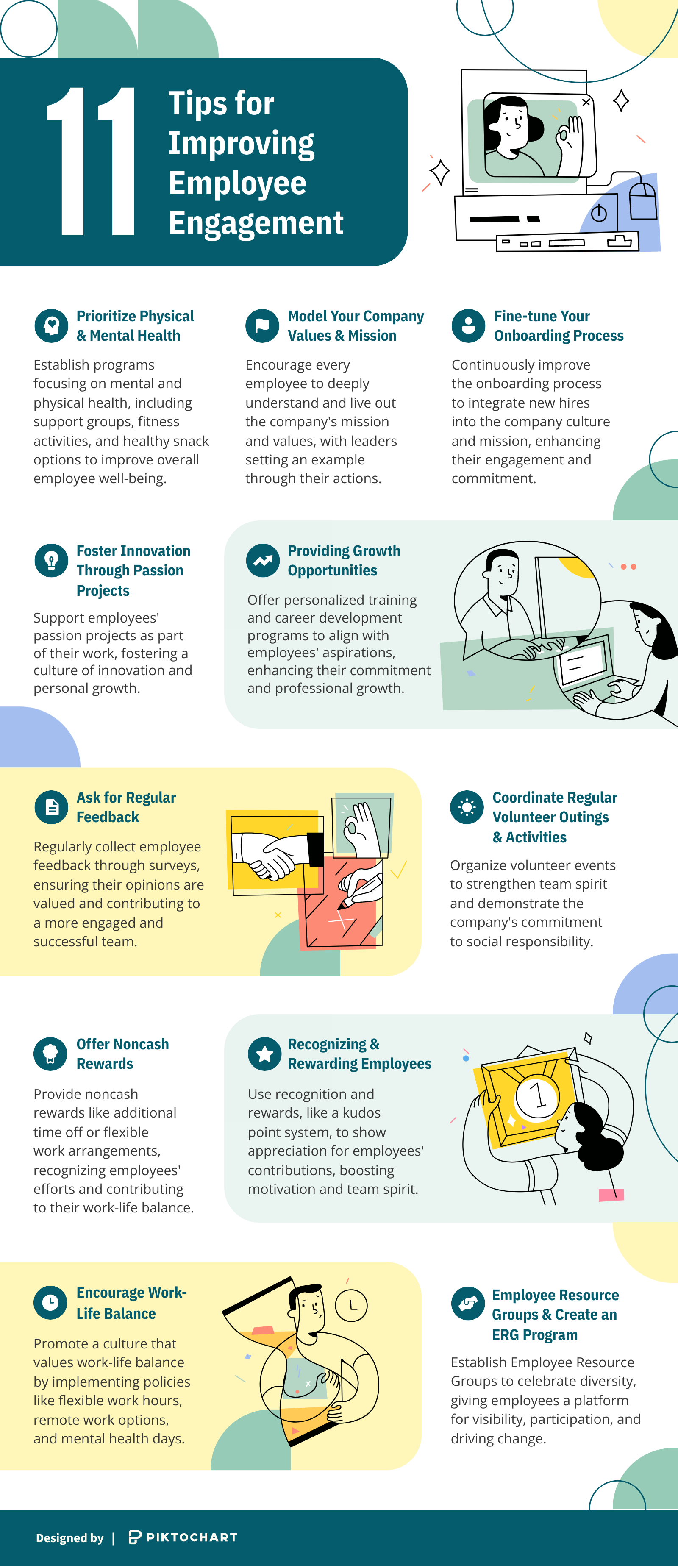
What Is Employee Engagement?
Employee engagement can mean different things depending on who you ask. But, let’s look at a few common explanations.
David MacLeod, who co-founded Engaging for Success, describes it like this:
“Employee engagement is a workplace approach designed to ensure that employees are committed to their organisation’s goals and values, motivated to contribute to organisational success, and are able at the same time to enhance their own sense of well-being.”
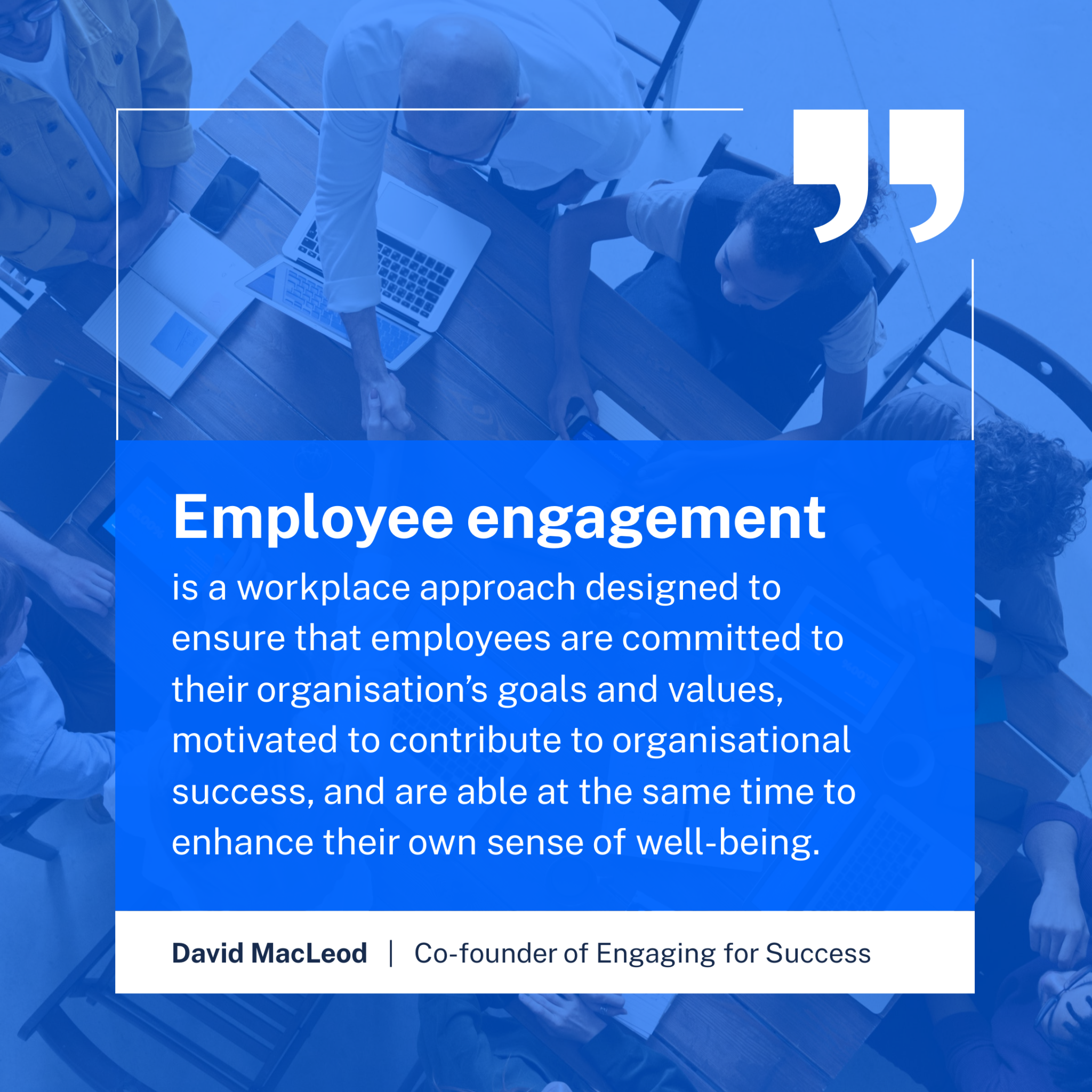
Others say it’s about how often employees show up and how much they enjoy their work.
John Baldini, a leadership and management expert, puts it simply:
“Quite simply, employee engagement is do your people want to come to work and do they like the work they do.” – John Baldini, Expert on Leadership and Management
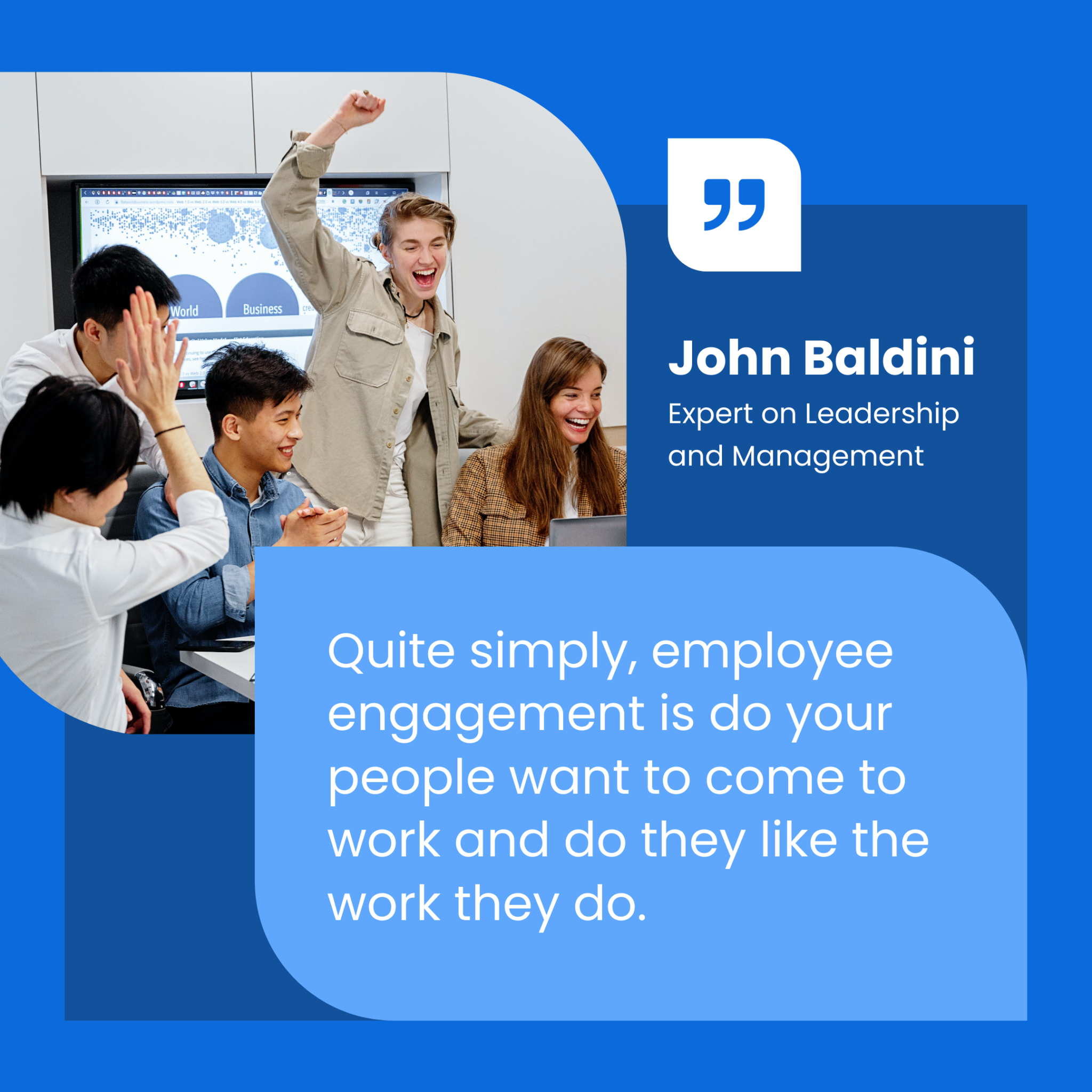
Here’s another quote for good measure. Culture Amp, says:
“Employee engagement is a metric that represents the levels of enthusiasm employees feel toward their organization.”
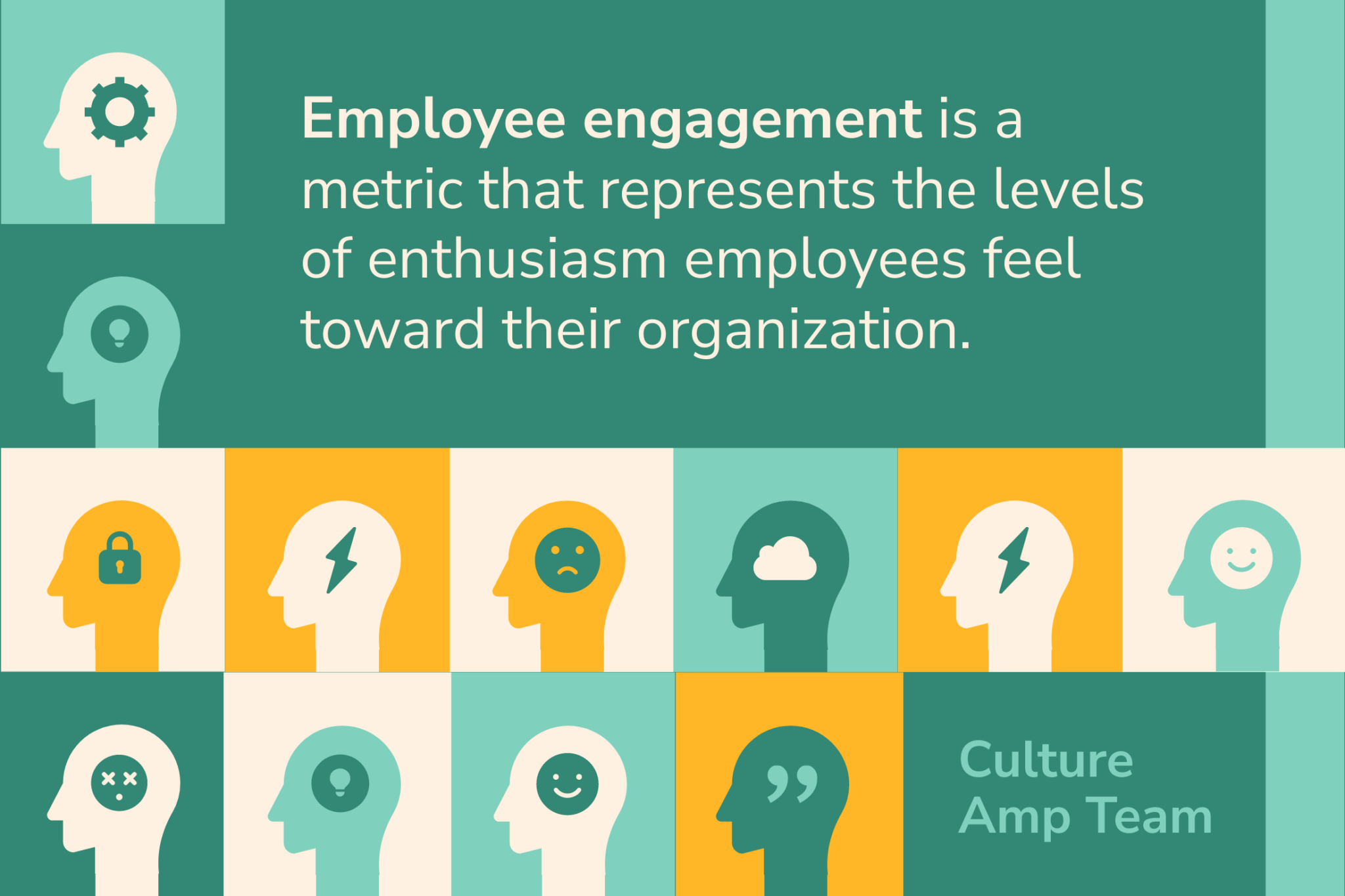
These definitions have some differences, but they share a common idea. Employee engagement is about two things: how employees feel about their company and how the company helps employees do well in their roles.
So, what can you do about this? We’ll dive into that soon.
It’s one thing to try and make the workplace better for your team, but it’s tricky if you don’t know what they actually want. After all, it takes two to tango.
Remember, caring about employee engagement is the first step in improving your workplace.
Engaged employees don’t just come to work; they bring their best. They’re full of ideas, work hard, and achieve great things. When someone loves their job, it shows, and it can lift everyone’s performance.
Let’s go deeper and explore some employee engagement strategies.
11 Ways to Improve Employee Engagement
Nurturing a positive company culture is vital for employee engagement. This culture is not static; it adapts continuously, aiming to provide the best working environment for teams.
Central to this adaptation is employee feedback, which guides the company in aligning with employee needs and aspirations. By listening and responding to this feedback, and incorporating team building activities, companies can effectively support their employees in reaching their full potential.
Prioritize physical and mental health
Now more than ever, it’s vital that you put programs in place that focus on both mental and physical health.
A recent survey by the American Psychological Association revealed that 92% of employees acknowledged that it’s important for their companies to value their emotional and physical well-being.
There’s less stigma around mental health and well-being, but some employees may still struggle to verbalize their need for this type of support. Just by having support groups and Employee Assistance Programs to use, it’s easier to take advantage of services to improve mental health.
For fitness and physical health, you can start small, such as organizing lunchtime yoga sessions or “Fit Fridays” where you plan an outdoor activity before work begins.
If you have an office space and a breakroom, you can post a poster or infographic sharing the health benefits of the activities you’re planning.
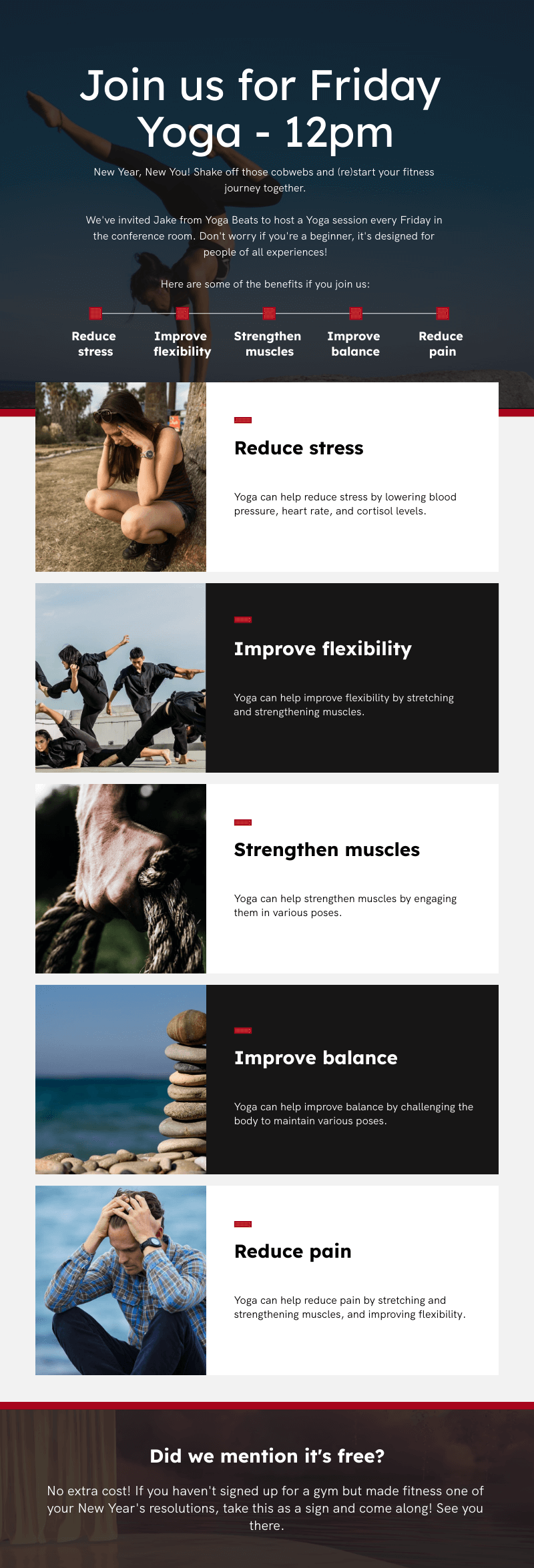
Like this infographic? You can make your own with our generative AI infographic tool in less than 10 seconds. It’s free to sign up, and no design experience needed.
To encourage more participation, you can create challenges to add some accountability and healthy competition into the mix. Again, it can be as simple as tracking steps or water intake each week. At the end of each week, the winner gets a prize. Gamifying the activity can be a fun way to encourage healthy habits.
And it’s not just about big programs. Simple things matter, like having fruits instead of chips in the break room. In ezCater’s 2023 Food for Work report, more than 80% of surveyed employees said office snacks improve teamwork and build connections between their peers. Also, 46% of employees reported that having healthy snack options at work increases the chances of staying in their roles.
Whatever you decide on, make sure there’s something for all employees. As Kelly Hartman, Chief Wellness & Engagement Officer at Flywire, mentioned in an interview:
“Make sure you diversify the offering. There’s no one size that fits all. You’ve got to realize every person is an individual who has different needs, so make sure it’s holistic, that it touches everything from financial wellbeing to mental wellbeing, physical, spiritual and social wellbeing.”
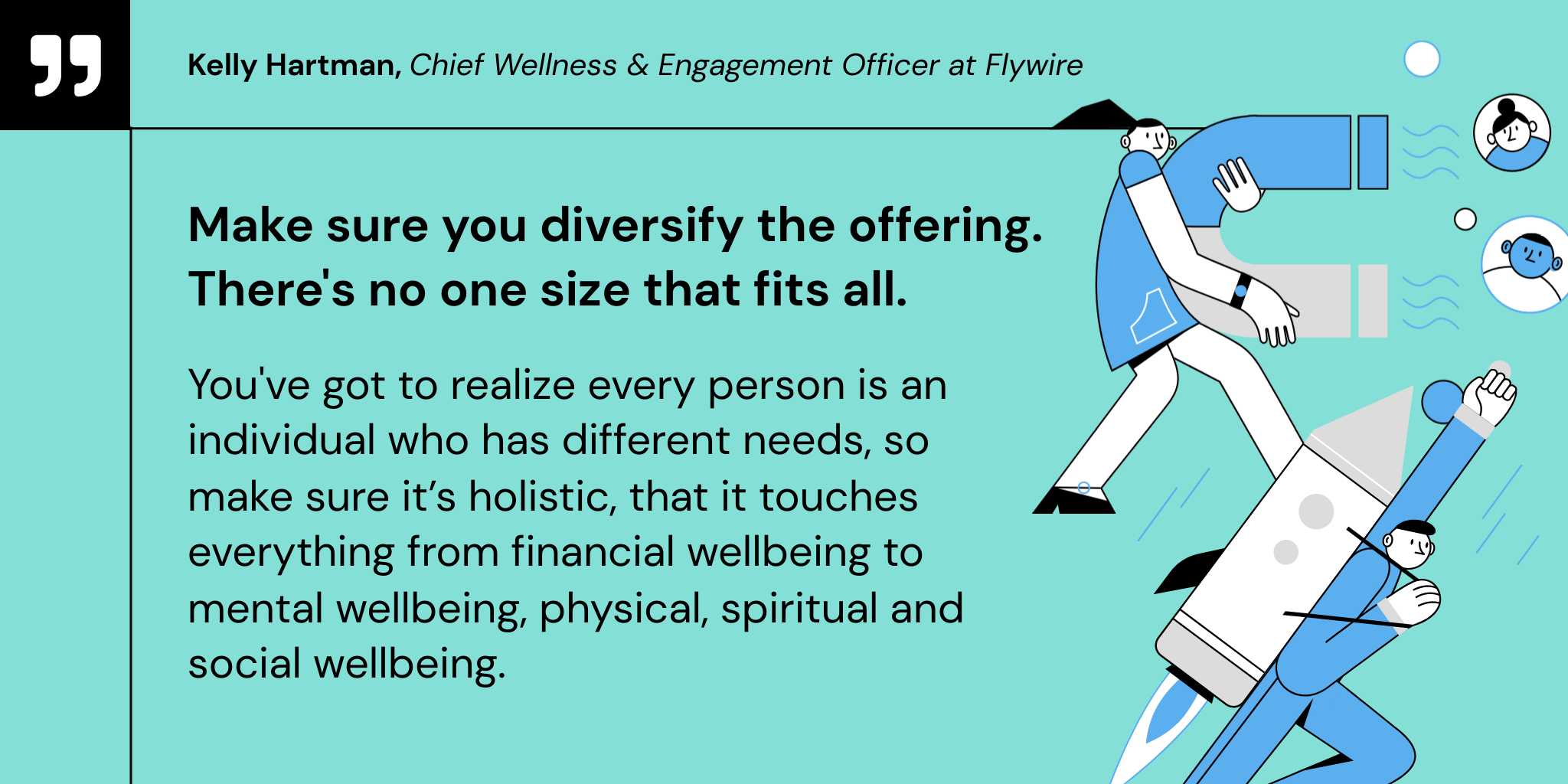
Remember, it’s not just a one-time thing. Building a culture of well-being means keeping the conversation going, trying new things, and listening to what your team needs.
Model your Company values and Mission
Think of your company like a sports team. For the team to win, every player needs to know the game plan and play by the rules. In the same way, every person in your company should really understand and follow your company’s mission and core values. It’s not enough just to have these ideas on your website or on a poster; they should be part of everything you do.
Your leaders are like team captains. They need to show everyone how it’s done by always acting in ways that match your company’s values. This isn’t just talking the talk, but walking the walk. When your team sees leaders doing this, it’s like a guide for them to do the same in their jobs.
While it’s simple to say that you follow your company values, there are practical ways to encourage employees to model the mission statement and core values. For example, if a core value is being innovate, you can tie specific KPIs that allows employees to propose and lead new projects to demonstrate innovation.
Naturally, modelling values isn’t a one and done deal, but an ongoing process. You’ll need to continually collect feedback and compare metrics to see how effective your leaders and workforce are reflecting the company culture.
Providing Growth Opportunities
As LinkedIn Senior Director of Talent Development, Stephanie Conway, said in the 2023 Global Work Trends report,
“We’ve long known that employees consider career-development opportunities to be one of the top reasons to stay at – or leave – their company. The difficult but important work comes in better understanding what career development really means to our diverse employee populations.”
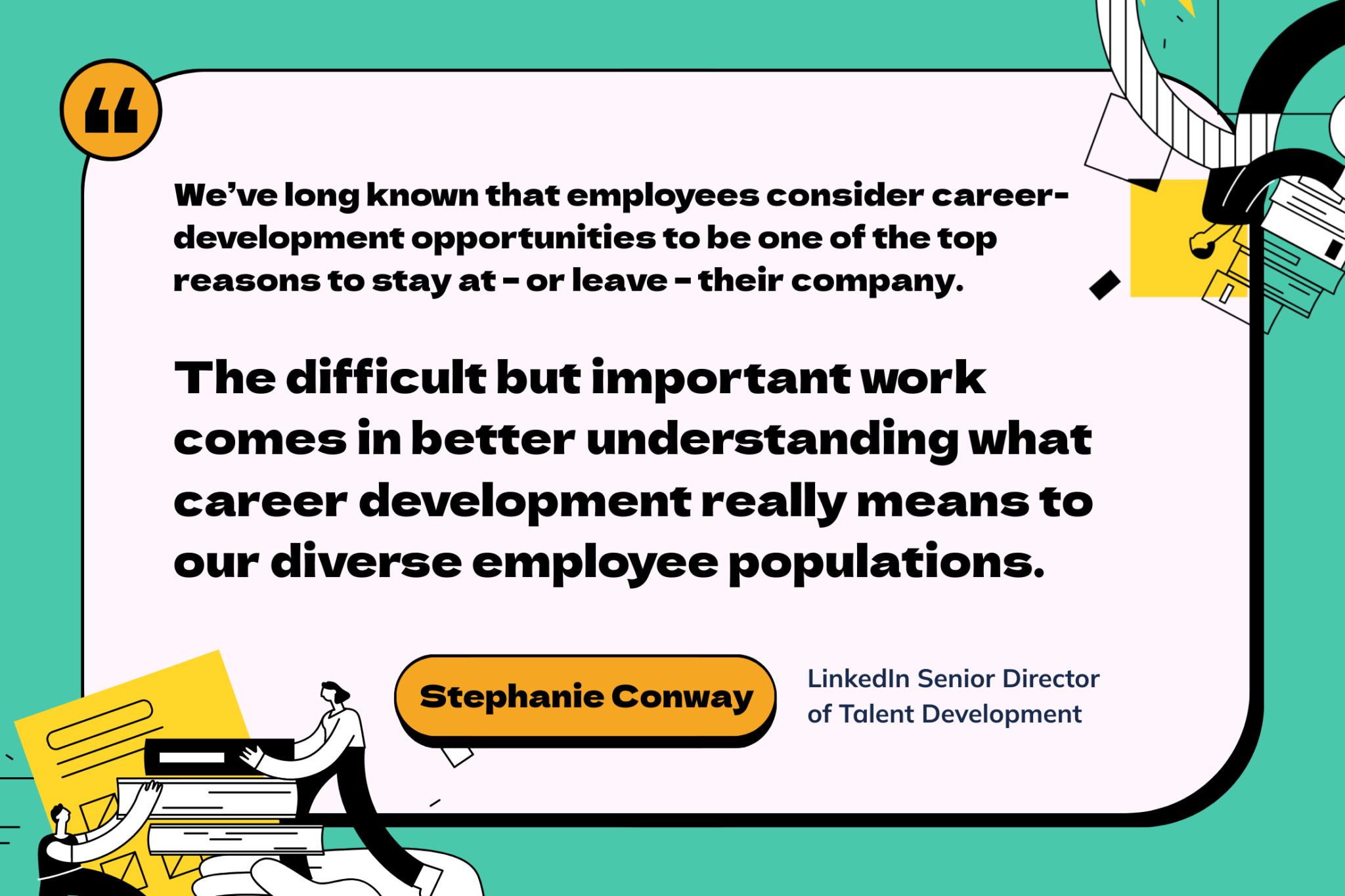
By creating career paths tailored to individual aspirations, you help each employee see a bright future in your organization. This boosts their commitment and enthusiasm for their work.
To personalize career growth opportunities, offer training programs that align with each person’s career goals. This approach aims to empower employees so they feel valued and seen, not just like a small part of a big machine. Plus, focusing on employee development makes your company a go-to place for those seeking to grow and excel professionally.
Recognizing and Rewarding Employees
Recognition is a key tool for boosting employee engagement and showing your team that their hard work is valued. A recent survey by Nectar HR showed that over 83% of employees have higher motivation to do better at work when they receive recognition.
For leaders, it’s important to understand that people need feedback. When team members feel appreciated, they’re more committed to their jobs, which leads to less turnover and happier employees. Meeting this need can really help keep your team members around.
You can recognize employees in team meetings or give them special shoutouts in your company newsletter. There’s not really a bad time to celebrate your coworkers.

If you like this template, you can edit it to use for yourself below.
Building a culture of recognizing and celebrating coworkers takes time. It should become a part of your company’s way of doing things, where employees are rewarded for showing this kind of teamwork. Rewards can be money, but they can be other kinds of rewards too.
For example, at Piktochart, we use a system of kudos points. Coworkers can post a kudos, where they share when someone does a great job and explains why they’re receiving kudos. In return, they get points and a public shoutout so everyone knows about their good work.
These kudos points can be traded in for gifts. While the rewards aren’t the main motivation, they’re a fun extra that encourages everyone to keep up the good work.
Foster innovation Through Passion Projects
Did you know Google’s famous ‘20% time’ policy led to the creation of Gmail? Encouraging passion projects can lead to similar groundbreaking innovations in your company, and engage employees better.
This kind of freedom can lead to big things in your company too. For instance, a software developer might develop a new app feature that makes it better for users.
Managers showing support for these projects lets employees know their personal interests matter. You can encourage this by letting employees work on passion projects as part of their KPIs.
This not only boosts their enthusiasm for work but also helps grow a culture where personal and professional growth are equally important. When employees make breakthroughs on projects they’re passionate about, it benefits the whole company.
Ask for regular feedback
Regular feedback is crucial for keeping communication open and constantly improving how things work. When team leaders listen to their team members, they show that each opinion counts. This involvement is key to making employees feel like they’re part of something bigger.
Use quick, easy-to-answer surveys to regularly check in with your team about how they’re feeling and what ideas they have. McKinsey have found success by running weekly pulse surveys to see check in on how employees are feeling, and receive a 90 percent response rate.
Employees who feel heard are more likely to stay with the company and put in their best efforts, leading to a stronger, more successful business.
Coordinate regular volunteer outings and activities
Why not boost team spirit and enhance your company’s social responsibility by coordinating regular volunteer outings and activities? Volunteer events are more than just an opportunity to give back; they’re a powerful tool to improve employee engagement. By allowing employees to step outside the office and contribute to a cause, you cultivate a great company culture that aligns with your company’s core values.
These outings aren’t only about team building; they’re about forging an emotional connection between your employees and the broader community. When you prioritize these activities, you’re sending a clear message: your organization cares about more than just profits—it cares about people.
Incorporating volunteerism into your employee engagement goals can lead to a more connected and motivated workforce. It encourages employees to interact with each other in settings that are far removed from the pressures of deadlines and meetings, fostering relationships that are built on shared experiences and values.
Finetune your onboarding process
To ensure your new hires become fully engaged team members, it’s crucial to fine-tune your onboarding process. This pivotal stage in the hiring process sets the tone for an employee’s journey with your company.
A comprehensive onboarding process does more than introduce the nuts and bolts of a job; it integrates new employees into the fabric of your organization’s mission and culture.
Begin by creating a structured employee training plan that encapsulates your company’s values. Explain not only the ‘what’ but the ‘why’ behind each protocol, highlighting how their roles contribute to the greater objectives. Make them feel like part of the team from day one by connecting their work to the organization’s mission.
You must also evaluate processes regularly to keep the onboarding experience fresh and relevant. Solicit feedback from new hires and seasoned staff to find gaps and opportunities for improvement. Remember, onboarding isn’t a one-time event but an ongoing process that reflects the dynamic nature of your business.
Lastly, don’t overlook their physical health and well-being, as these are crucial for sustained engagement. Offer resources and initiatives that support a healthy work-life balance, underscoring that your company invests in its people holistically. By doing so, you’ll cultivate a workforce that’s not only skilled but also deeply connected and committed to your vision.
Employee Resource Groups and Create an ERG Program
Building on your onboarding improvements, you’ll find that establishing Employee Resource Groups (ERGs) can further amplify engagement by fostering a workplace where diversity is celebrated and every voice is heard. ERGs are a powerful tool in your strategy on how to improve employee engagement. They provide employees with a sense of visibility and value that’s paramount for the most engaged employees.
Creating an ERG program isn’t just about ticking a box; it’s an investment in improving employee engagement that leads directly to better business outcomes. These groups are voluntary and employee-led, giving your team the reins to drive change and increase employee engagement through active participation and leadership.
By encouraging the formation of ERGs, you’re not only acknowledging the cultural uniqueness of your workforce but also leveraging that diversity to foster innovation and customer loyalty. When employees feel represented and supported, their engagement soars, and they’re more likely to contribute meaningfully to the company’s goals.
Offer Noncash Rewards
If employees are satisfied with their salary, offering monetary rewards probably won’t move the needle much.
A recent large-scale survey showed that only 5% of employees wanted cash rewards. Instead, 61% prefer things like more time off or flexible work arrangements. These kinds of rewards really matter as they contribute to better work-life balance.
They also show employees are valued and their hard work is noticed. Unlike financial incentives that can quickly be forgotten after the next paycheck, noncash rewards have a lasting impact.
Encourage Work-Life Balance
Work often blends into personal time thanks to technology that allows us to work remotely or on a hybrid schedule. That’s why encouraging a healthy work-life balance is crucial for employee well-being and productivity.
A recent study by Harvard Business Review highlighted that 55% of employees struggled to find a work-life balanced, while 85% of surveyed employees said their wellbeing was getting worse as a result of chronic work stress.
To foster a better balance, consider flexible work schedules that allow employees to manage their personal responsibilities alongside their professional ones. This flexibility can reduce stress and improve overall job satisfaction.
Remote work options have also shown to be beneficial. Allowing employees to work from home part of the week can decrease commute stress and give them more control over their work environment.
Incorporating mental health days into your leave policy acknowledges the importance of mental well-being. It encourages employees to take time off when needed, without the stigma of traditional sick leave.
Promoting work-life balance isn’t just about reducing hours; it’s about creating an environment where employees feel their personal time is respected and valued.
Final thoughts
Wrapping up this article, let’s talk about a fun, easy way to boost employee engagement – infographics! With Piktochart, you can turn complex ideas into cool, clear visuals. More than just pictures, they tell a story, simplify complex information, and can visually celebrate team successes and milestones.
Infographics are great for sharing achievements, explaining goals, or just keeping everyone in the loop. They make information easy to understand and fun to read. And you don’t need to be a designer to create them.
Ready to make your team’s communication more engaging? Sign up for Piktochart and start creating your own awesome infographics today!
Frequently Asked Questions
Why is it important to improve employee engagement at the workplace?
Boosting employee engagement is key because engaged employees are more productive and happier. They care more about their work, leading to better results and a stronger company. When employees are engaged, they’re more likely to stay with the company, reducing turnover costs. Plus, they contribute to a positive work environment, making the workplace better for everyone.
What can leaders do to improve employee engagement?
Leaders can improve engagement by actively listening to their team and responding to their needs. This can include regular check-ins, acknowledging achievements, and providing opportunities for growth and development. Leaders should also create a supportive work environment where everyone feels valued and part of the team. Encouraging open communication and feedback, and showing genuine interest in employees’ well-being are also essential.
How Do Individual Personality Traits and Personal Life Circumstances Affect Employee Engagement in the Workplace?
Your personality traits and personal life significantly impact your engagement at work. They shape your motivation, adaptability, and interaction with colleagues, affecting overall job satisfaction and commitment.
Can Employee Engagement Be Accurately Measured Across Different Industries and Job Roles, or Does the Concept Vary Too Widely?
Yes, you can measure employee engagement across industries and roles, though methods may vary. It’s crucial to tailor metrics to each sector’s unique context to get accurate, actionable insights.
What Are the Potential Negative Consequences of Overemphasizing Employee Engagement in the Workplace?
Overemphasizing employee engagement can lead to burnout, as you might neglect other crucial aspects like work-life balance and individual autonomy. It’s about finding the right balance for sustainable, long-term engagement.
How Do Remote and Hybrid Work Environments Challenge Traditional Methods of Improving Employee Engagement?
Remote and hybrid work can make fostering connection and monitoring engagement tougher for you, as traditional in-person strategies often don’t translate well to virtual settings. You’ll need to adapt your approach creatively.
How Should Companies Approach Employee Engagement for Multi-Generational Workforces With Diverse Values and Expectations?
You should tailor engagement strategies to address the unique needs and values of a multi-generational workforce, ensuring inclusivity and respect for diverse perspectives to maintain a cohesive and motivated team.
Elevate your workplace experience!
Foster collaboration, boost morale, and drive results with our employee engagement solutions & templates.
Begin today!